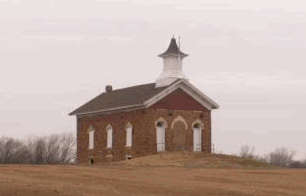In 1954, Congress authorized the construction of Melvern Lake as a multipurpose project for flood damage reduction and water resource development. While most of the lake's tangible benefits are attributed to its ability to prevent flood damage, lake storage also supplies water for several local communities. Recreation, fish and wildlife conservation, and water quality are other important benefits of the lake. Following construction and impoundment, the lake was dedicated in 1975.
The Melvern Project consists of 23,362 acres of federal owned lands. The lake itself comprises 6,930 acres. The remaining acreage has been devoted to park development and wildlife management. Melvern is a key unit in the system of flood damage reduction projects within the Marais des Cygnes River Basin. It is also part of the network of lakes that provide flood damage reduction on the Osage, Missouri, and Mississippi Rivers.
The earliest known inhabitants of the Melvern Lake area was the Kansa Indians. They occupied the Melvern Lake area for nearly a century when, in 1825, they ceded most of their territory to the United States. In 1864, a reservation for the Sac and Fox Indians was established in the southern two-thirds of Osage County and parts of Lyon, Coffey and Franklin counties. In 1867, the area was opened to white settlement and the reservation was removed from the Marais des Cygnes River Valley.

In 1868, a town called Olivet sprang up in the Marais des Cygnes valley. This new town was established by the Swedenborgian Followers from England. It was proposed by the founders of the town to build a college and make Olivet the headquarters for the Swedenborgian Chuch for the entire western United States. The town grew to over 300, but later struggled because the proposed railroad went another route. In 1873, a prairie fire swept through the town destroying part of it. The town was completely gone by 1885.
Arvonia was the second town to be founded in the river valley. Originally settled by Welsh farmers and coal miners in 1869, the town was settled, like Old Olivet, in anticipation of the railroad which was to run adjacent to the Marais Cygnes River. Unfortunately, the line did not run to Arvonia. Though it did grow to over 300 people by 1879, it slowly dwindled to just a handful today.